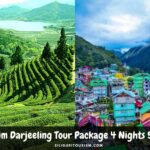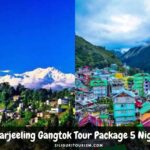Dzongu Valley is a peaceful and scenic area known as the homeland of the Lepchas. From its villages, you can enjoy clear views of the Kanchenjunga mountains.
Surrounded by green forests and tall hills, Dzongu is a perfect place for those who love quiet natural surroundings.
The valley is bordered by the Teesta River in the southeast, the Tholung Chu River in the northeast, and the mountains of the Kanchenjunga Biosphere Reserve in the west.
To visit this area, you need a permit from the Sikkim Government.
Places to Visit in Dzongu Valley
Dzongu Valley has many spots worth visiting, along with its natural beauty.
1. Charming Villages
The valley has several villages worth exploring. Passing Dang is a popular one, located 30 minutes from Mangan.
In Upper Dzongu, Kusong is the highest village and depends mainly on cardamom farming.
Other notable villages include Lingthem, Rukum, Pentong, Sakyong, Tingvong, and Lingzya.
HeeGyathang is a peaceful village in Lower Dzongu, reachable by jeep from Passingdang. It has a small lake surrounded by trees and prayer flags.
Locals believe that the silver fish in the lake were formed from a goddess’s lice and must be protected.
A local clan named Hemos believes their lives are tied to the fish, so they feed them regularly.
Pentong is the last village in this area and sits close to the mountains. You must hike through forests and narrow paths to reach it.
Once there, you can enjoy the view of two hilltops called Tarbot and Tarbi.
2. Tholung Monastery
Tholung Monastery, built in the 18th century, is another key spot in Dzongu Valley. Located at 8,000 feet, it stores ancient items from Tibetan Buddhism.
These are displayed once every three years. The monastery also has tools used by early Lepchas and old Buddhist texts.
3. Traditional Lepcha Museum
Located in Namprikdong near the Teesta and Rongyung Chu Rivers, the Traditional Lepcha Museum shows the lifestyle of the Lepcha people.
Built like a Lepcha house, it contains tools, clothes, and other objects from their daily life.
4. Hot Springs of Dzongu
Near Lingdem Village in Lower Dzongu, there is a forest hot spring with two log cabins, one for men and one for women.
The sulfur-rich water is said to help heal the body. Visitors often enjoy a relaxing bath while watching the nearby forest.
5. Lingzya Waterfall
Lingzya Waterfall is the most attractive waterfall in Dzongu. It stands at 300 feet and is located in Upper Lingzya village.
To get there, you need to pass through the villages of Nom, Shibing, and Passingdang, and cross bamboo bridges.
The peaceful setting and fresh water make it a good place to take photos and enjoy a cold bath. You can also try hammer fishing here.
6. Passindang Village
Most travelers stay overnight in Passindang Village. Homestays in the village provide basic lodging and food.
Locals are friendly and happy to share their culture. The village has a calm climate, green hills, and traditional drinks like Chang, a millet-based beer made at home.
7. Peaceful Lakes
Dzongu Valley also has several calm lakes. You can reach Keushong, Dawathang, Ringdem, and Tung Kyong lakes with a one-day trek.
Lepcha people believe these lakes are holy and that their ancestors came from them. Visitors can take photos and enjoy the views.
How to Reach Dzongu
You can travel from Gangtok to Mangan by shared or hired car. From Mangan, rent a car to reach Dzongu. Prepaid taxis are available from Siliguri, NJP, or Bagdogra.
NJP is the nearest railway station, and Bagdogra is the nearest airport. The total distance from Bagdogra/NJP to Dzongu is around 75 km, and the journey takes about 7 hours.
Dzongu is a protected zone, so visitors need a permit. A travel agent can help you get one. You need a valid photo ID (like a Voter Card) and two passport-size photos.
Things to Do in Dzongu Valley
There are many outdoor activities to enjoy here. The most common are:
1. Trekking
Dzongu Valley is great for trekking. The green landscape, mountain views, and blooming flowers make the trek enjoyable.
One common route is from Lingzya Village to Tholung Monastery, which takes about 5 hours. Trekkers must cross Tholung Chu stream.
More experienced trekkers can go to Kushon Pass, which is at 15,000 feet. This trek takes about five days.
2. Bird and Butterfly Watching
Dzongu Valley is a good place to watch birds and butterflies. Over 27 butterfly species can be seen, especially near Rongyung Chu, Dingdong, and Namprikdang villages.
The valley also has more than 200 bird species. The forested hills give shelter to many birds. You can spot them using a camera or binoculars.
3. Fishing
You can fish in the rivers such as Teesta, Rongyoung Chu, and Rungkyoung. Common fish include Mahaseer, trout, Katla, and others.
Best Time to Visit Dzongu
March to May is the best time to visit. The weather is pleasant and skies are clear, making the mountain views beautiful.
From June to September, heavy rain causes landslides and poor road conditions. It’s not a good time to travel, and birdwatching is harder due to the fog.
December and January are cold months. Snow-covered mountains are visible. If you plan to visit during this time, bring warm clothes.
Hotels and Homestay Options in Dzongu Valley
Dzongu has several homestays where travelers can stay. To reach some of them, you may need to cross a lake formed in 2016 by boat.
These places offer basic facilities but not luxury services, as they are in a remote area. However, they provide a comfortable and peaceful stay.
| Get a Free Tour Quote |
|---|




